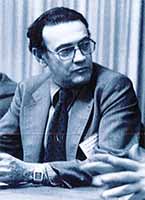Ivar STAKGOLD


|
Ivar STAKGOLD |
|
 |
Ivar Ŕ nato nel 1925 vicino a
Oslo, in Norvegia ma trascorse gran parte della
sua prima infanzia a Bruxelles, in Belgio. Per sfuggire all'inizio della seconda
guerra mondiale nel 1940, la sua famiglia che era di origine ebrea, intraprese
un tortuoso viaggio attraverso la Francia, la Spagna e il Portogallo per
raggiungere la Repubblica Dominicana. Infine nel 1941 i Stakgold emigrarono negli
Stati Uniti e si
stabilirono a New York.

Fu in quel Paese che Ivar conobbe per la prima volta il bridge mentre aspettava il visto per poter emigrare negli USA con la famiglia.
Negli USA Ivar studi˛ prima alla Horace Mann School e poi alla Cornell University ricevendo il suo dottorato ad Harvard nel 1949. Ha vissuto fino al 1956 a Boston dove Ŕ stato assistente presso la Harvard University, poi si Ŕ trasferito presso l'ufficio di ricerca dell'Accademia Navale a Washington e dal 1962 Ŕ stato per 8 anni docente di matematica presso la Northwestern University di Chicago.
Si Ŕ poi trasferito a Wilmington nel Delaware dove Ŕ stato per lunghi anni preside di facoltÓ preso la locale universitÓ che sotto la sua guida acquisto prestigio internazionale e che lo nomin˛ professore emerito.
Quando la prima moglie Alice Cox, che era una valente giocatrice con la quale Ivar vinse il campionato a squadre miste ai NABC's del 1969, si ammal˛ di cancro, si trasferirono nel Delaware dove vivevano entrambe le mamme della coppia e dove la moglie visse fino al 1994, quando dovette soccombere ad una recrudescenza del suo male. Dalla loro unione nel 1965 nacque Alissa.
Nel 2008 si Ŕ trasferito a San Diego dove ha preso una posizione come ricercatore presso la locale universitÓ e dove ha vissuto l'ultimo decennio della sua intensa vita accanto a Lainie-Lesser Mark.
Come bridgista ha avuto il suo momento di gloria a metÓ dello scorso secolo quando si Ŕ fregiato della medaglia d'argento nella Bermuda Bowl del 1959 ed ha partecipato con la Nazionale USA alle Olimpiadi del 1960.
In quel periodo, oltre al titolo conquistato in coppia con la moglie, ha vinto la Reisinger, il Silodor e la Vanderbilt nel 1958 e la Spingolds nel 1962.
Poi, la carriera scientifica e la famiglia lo hanno allontanato dai tavoli per quasi 30 anni, ma la passione non si Ŕ spenta e lo ha riportato nell'agone bridgistico verso la fine del secolo scorso.
Scomparve il 29 maggio del 2018.
![]()
![]() Ivar was born in 1925 near Oslo, Norway, and spent
most of his early childhood in Brussels, Belgium. To escape the beginning of the
Second World War in 1940, his family who was of Jewish origin, undertook a
tortuous journey through France, Spain and Portugal to reach the Dominican
Republic. They emigrated to the United States in 1941 and settled in New York.
Ivar was born in 1925 near Oslo, Norway, and spent
most of his early childhood in Brussels, Belgium. To escape the beginning of the
Second World War in 1940, his family who was of Jewish origin, undertook a
tortuous journey through France, Spain and Portugal to reach the Dominican
Republic. They emigrated to the United States in 1941 and settled in New York.
It was in that country that Ivar met the bridge for the first time while waiting for a visa to emigrate to the USA with his family.
In the USA Ivar first studied at the Horace Mann School and then at Cornell University receiving his doctorate at Harvard in 1949. He lived until 1956 in Boston where he was an assistant at Harvard University, then he moved to the research office of Naval Academy in Washington and since 1962 he has been a mathematics teacher for 8 years at Northwestern University in Chicago.
He then moved to Wilmington in Delaware where he was for many years a dean of faculty at the local university, which under his guidance acquired international prestige and who appointed him professor emeritus.
When the first wife Alice Cox, who was a talented player with whom Ivar won the mixed-team championship at NABC's in 1969, fell ill with cancer, they moved to Delaware where both the both mothers lived and where the wife lived until 1994, when he had to succumb to a resurgence of his illness. From their union in 1965 Alissa was born.
In 2008 he moved to San Diego where he took a position as a researcher at the local university and where he lived the last decade of his intense life next to Lainie-Lesser Mark.
As a bridge player he had his moment of glory in the middle of the last century when he won the silver medal in the Bermuda Bowl in 1959 and participated with the US National Team at the 1960 Olympics.
In that period, in addition to the title won in tandem with his wife, he won the Reisinger, the Silodor and the Vanderbilt in 1958 and the Spingolds in 1962.
Then, the scientific career and the family have moved him away from the tables for almost 30 years, but the passion has not turned off and brought him back to the bridge stage towards the end of the last century.
He disappeared on May 29, 2018.
| Precedente / Previous |